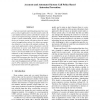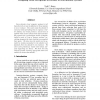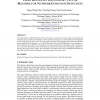363 search results - page 3 / 73 » Modeling Attack Behaviors in Rating Systems |
DSN
2006
IEEE
13 years 12 months ago
2006
IEEE
One way to prevent control hijacking attack is to compare a network application’s run-time system calls with a pre-defined normal system call behavior model, and raise an alert...
ACSAC
2004
IEEE
13 years 9 months ago
2004
IEEE
Since attackers trust computer systems to tell them the truth, it may be effective for those systems to lie or mislead. This could waste the attacker's resources while permit...
ICPPW
2002
IEEE
13 years 10 months ago
2002
IEEE
Incidents such as Solar Sunrise and Nimda demonstrate the need to expressively model distributed and complex network attacks. To protect information systems, system administrators...
IWIA
2005
IEEE
13 years 11 months ago
2005
IEEE
Previous quantitative models of security or survivability have been defined on a range of probable intruder behavior. This measures survivability as a statistic such as mean time...
CORR
2010
Springer
13 years 5 months ago
2010
Springer
The main function of IDS (Intrusion Detection System) is to protect the system, analyze and predict the behaviors of users. Then these behaviors will be considered an attack or a ...



